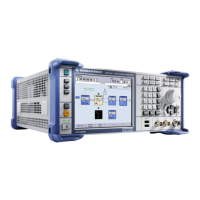Instrument Function
R&S
®
SMBV100A
324Operating Manual 1407.6062.32 ─ 08
nate between the individual waveform segments without experiencing any delay due to
the loading operation.
There are however additionally requirements conserning the clock settings if some spe-
cial triggering is necessary.
If very high switchover speeds are required, the test signals can be continuously scrolled
through with the aid of an external trigger or by applying a predefined “play list”. For this
purpose the segments must have a common sample rate. If the combined waveforms
have different sample rates, they can be adapted to a common sample rate by resam-
pling. By the same procedure the instantaneous amplitude of the various waveforms can
be scaled to a common RMS level.
Typical applications for the multi segment mode are described in the section "Typical
Applications for Multi Segment Waveforms" on page 358.
Multi carrier waveforms consisting of up to 512 carriers modulated by user-selectable
baseband signals can be created in order to simulate complex multi carrier scenarios with
different baseband signals (e.g. CDMA2000 or 3GPP FDD).
Waveform sample rate
The Arbitrary Waveform Generator includes a resampling unit that interpolates the input
samples to reach a target digital output I/Q sample rate before digital-to-analog conver-
sion (DAC). The input sample rate finput is given by the default sample rate tag of the
waveform file or is set by the user in the ARB panel.
Depending on the hardware option R&S SMBV-B10/B50 or –B51 a 150 MHz or 90 MHz
system clock rate is used.
The resampling lowpass limits the signal bandwidth to a maximum of 1.36 x f
input
. Within
a bandwidth of 0.68 x f
input
the resampler lowpass is distortion-free. Thus, an externally
created waveform file have to provide a sample rate f
input
that is high enough for perfect
signal reconstruction.
For distortion-free resampling the lower bound of the required sample rate finput is cal-
culated by:
f
input
≥ Signal bandwidth / 0.68
In case of digital modulation this means that the oversampling factor (f
input
=symbol rate
x oversampling factor) that is applied for impulse forming is high enough.
The lower bound of the oversampling factor is given by:
oversampling factor ≥ signal bandwidth / (symbol rate x 0.68)
Example:
For the WCDMA standard 3GPP FDD with root raised cosine filter (α = 0.22) and a symbol
rate (chip rate) of 3.84 MHz the minimum oversampling factor is calculated as follow:
3.84 MHz x (1+0.22) / (3.84 MHz x 0.68) = 1.794
A modulation signal with a sample rate of 150 or 90 MHz respectively is passed directly
to the digital-to-analog converter (DAC), i.e. the resampling unit is bypassed (see figure
Baseband Signal - Baseband Block

